Geopolitics I: What Trump Wants from Canada & Mexico. It’s become abundantly clear to us what President Donald Trump wants from Mexico. To Trump, Mexico is a looming security threat. In his view, the country must reclaim control over the drug trade and the migrant flows spilling over the southern US border. His demand is simple: curb the cartels and stem the flow of illegal substances. But there’s more to it—Trump is furious that Chinese companies are increasingly using Mexico as a gateway to sidestep US tariffs. For Trump, Mexico’s economic proximity to China is an unacceptable strategic liability.
But what does Trump really want from Canada? That’s less obvious. The dealmaker-in-chief has an end in mind beyond the revenues from the 25% tariffs slapped and later removed on Canadian and Mexican goods (10% for Canadian oil).
A closer examination of this administration’s foreign policy blueprint hints at an overarching objective of economic and national security. For Trump to secure the US’s energy future, he needs the Western Hemisphere to function as a coherent energy bloc. This means both a reliable, unimpeded flow of oil and natural resources from Canada and a safer Mexico. And that means both countries under the US’s thumb.
Let’s break it down:
(1) The first global trade war punch. Trump’s recent flurry of tariffs is a textbook example of his “America First” foreign policy.
In late January, Trump fired a 25% tariff salvo at Colombia, punishing the nation for failing to control its citizens illegally present in the US. Colombian President Gustavo Petro initially brushed off Trump’s threats. But he quickly backed down, acknowledging publicly his responsibility for his country’s undocumented citizens. Why the sudden 180?
Trump had sent an unmistakable message on social media: “FAFO” (standing for “F*** Around, Find Out”) accompanied by an AI-generated image of a steely-eyed Trump in a gangster-style fedora. Leaving to the imagination what happens when one disrespects US interests packed a more powerful punch than any diplomatically worded retaliatory threat ever could.
Mexican President Claudia Sheinbaum earned a one-month pause on any tariffs after speaking with President Trump. She agreed to send 10,000 soldiers to the US–Mexico border to prevent the trafficking of fentanyl and other drugs, and assured Trump that Mexico is committed to stymying China. Speaking ostensibly to her domestic shareholders but using a Trumpian tone, Sheinbaum spoke about onshoring and “Made in Mexico” products. We think Mexico’s president is onboard with Trump 2.0 and the realignment of global trade/security.
(2) Canada’s strategic value. Unlike Mexico, Canada doesn’t pose a direct security threat to the US. It’s a peaceful, stable country with a population of just 38 million—roughly 10% of the US population—but one that controls vast tracts of resource-rich land.
Canada’s oil exports to the US make it an indispensable partner. It ships about 3.9 million barrels per day across the border, easily outpacing Mexico’s second-place 397,000 barrels. In fact, Canada is the largest foreign oil supplier to the US. Canadian and Mexican imports account for roughly 25% of the crude oil processed in US refineries. Trump’s tariffs on Canadian goods may appear as a protectionist move on the surface; but in reality, they’re a negotiation tactic aimed at asserting greater control over Canada’s most vital commodity, energy.
(3) The 51st state? Trump’s frequent suggestion that Canada should be the 51st US state has raised eyebrows in both Ottawa and Washington. Is it just bravado, or does Trump have a genuine vision for further integration with Canada? Given the current geopolitical landscape and Trump’s well documented tendency to push the envelope, we doubt this is idle talk. The tariffs are more than a mere trade measure; they are part of a larger bargaining strategy to bring Canada closer into the US orbit, especially when it comes to energy resources. Posturing aside, a North American security zone appears to be taking shape as of Monday afternoon.
It appears that Canadian Prime Minister Justin Trudeau, like Sheinbaum and Petro, has come to terms with the reality that not accepting the US’s demands would mean facing a dire economic future. Trudeau announced that tariffs would be paused for at least a month on the basis of a $1.3 billion border plan and a U.S.-Canada Joint Strike Force.
(4) The blueprint for US–Canada relations. Trump’s second term will likely be shaped by the Heritage Foundation’s Project 2025 mandate. This framework calls for a hemisphere-wide energy strategy that aims to reduce US reliance on foreign, often unstable, sources of fossil fuels.
In this context, Mexico and Canada become critical. The Project 2025 document states: “The [US] must work with Mexico, Canada, and other countries to develop a hemisphere-focused energy policy that will reduce reliance on distant and manipulable sources of fossil fuels. ...” If Trump is serious about achieving energy independence and security, Canada’s vast reserves and Mexico’s proximity to the US become indispensable components of this vision.
(5) Day One priorities. Trump’s goal isn’t just about curbing illegal immigration or stifling drug imports; it’s about reclaiming US sovereignty over energy and countering the destabilizing influence of external powers like China. Among Project 2025’s Day One priorities is tackling the proliferation of socialist and progressive regimes across the Western Hemisphere. The document also states that halting the fentanyl crisis—largely facilitated by Mexican cartels—is an urgent priority.
Reshaping US relations with its North American neighbors isn’t about dollars and cents; it’s about ensuring that the US holds the reins on global energy production and security—effecting a geopolitical recalibration.
Geopolitics II: Will Tariffs Boost Inflation? They didn’t in 2018, at least for US consumers. PPI finished consumer goods inflation averaged around 4.5% y/y from 2017-18, until the Federal Reserve’s monetary tightening started to weigh on price pressure in 2019.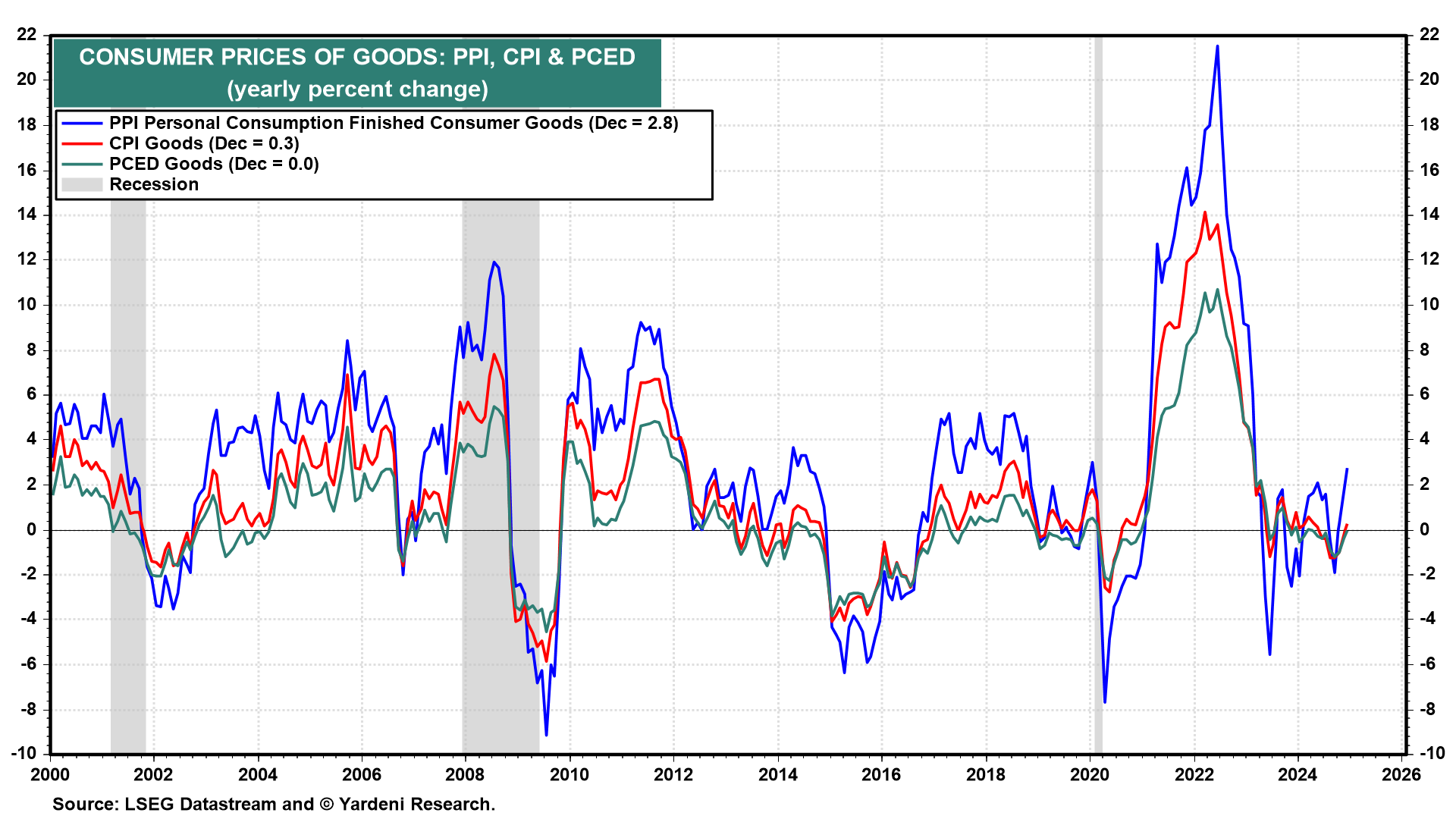
Yet CPI and PCED goods inflation remained subdued. Services inflation across measures failed to breach 3.0% y/y during Trump 1.0 as well. Ultimately, substitution and shifting consumer preferences can offset increases in the prices of certain goods.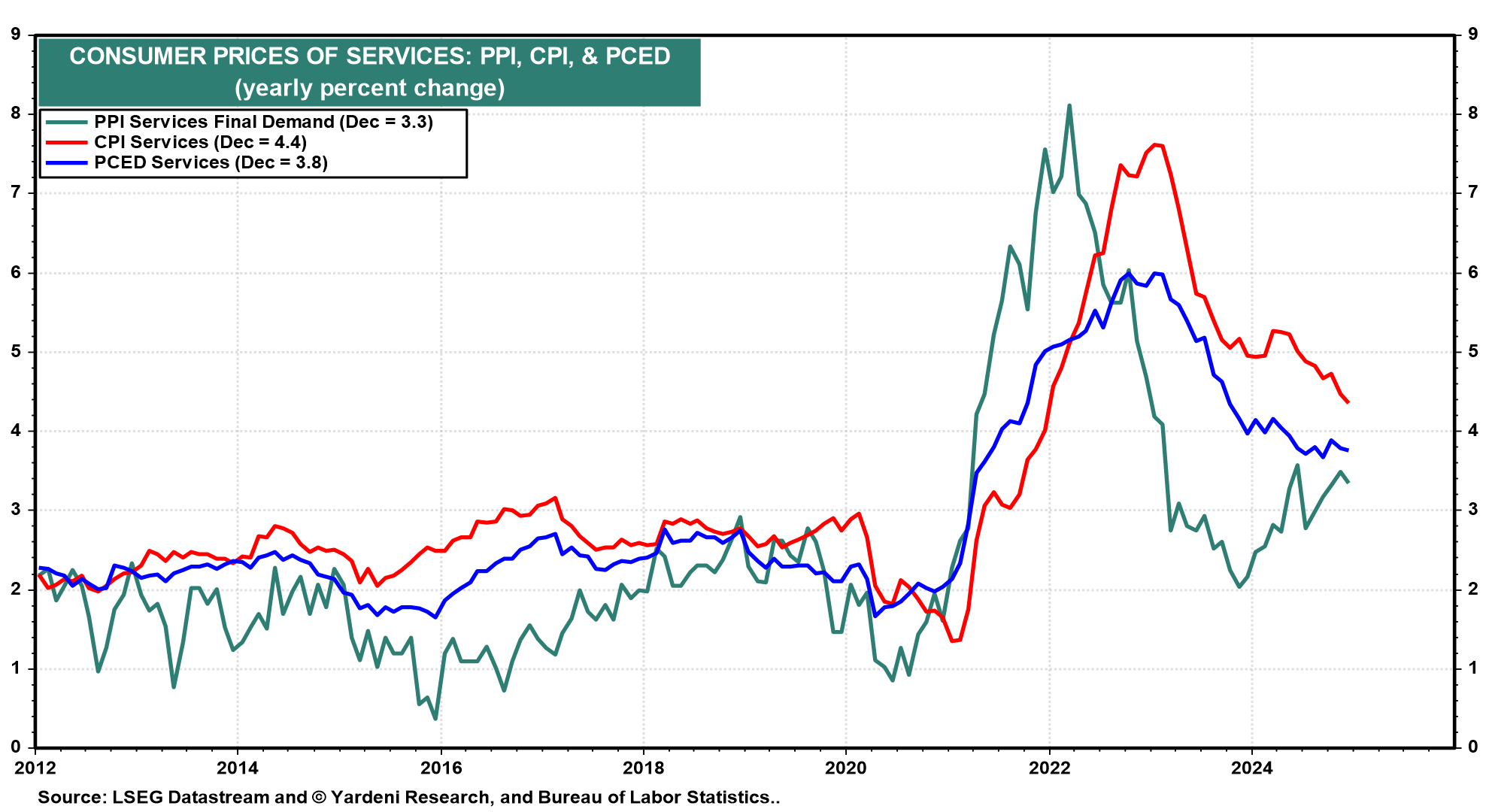
All that said, goods deflation has been a major tailwind for the Fed’s latest rate-cutting campaign. Because services disinflation has been slow and may be stuck at levels higher than would be consistent with 2.0% overall inflation, a supply shock that raises good prices would likely raise interest rates. The biggest risk in this for the Fed is that inflation expectations become unanchored and rise above 3.0%.
But we’re less worried about tariffs sparking an inflationary spiral than we are about them weighing on economic growth. A global trade war that severely hurts economic growth would be among the worst-case scenarios. However, it remains in our lowest-subjective-probability (20%) “what could go wrong” bucket. That’s because, in our view, it is better to think about such a shock as a tail risk with large consequences rather than a high probability event. So let’s dig deeper into the possible inflationary impact of tariffs:
(1) Inflation expectations. President Trump has inherited a very different economy than he did in his first term. Then, the economy was still relatively stagnant in the wake of the Great Financial Crisis. Policymakers were worried about deflation, not inflation. Today, the economy is at full employment, inflation is elevated, immigration is slowing, fiscal conditions are very loose, and monetary conditions are relatively neutral. Consumers are fed up with inflation—so the margin for error is thinner. The New York Fed’s consumer survey shows expected inflation running at y/y rates between 2.7% and 3.0% over the next several years.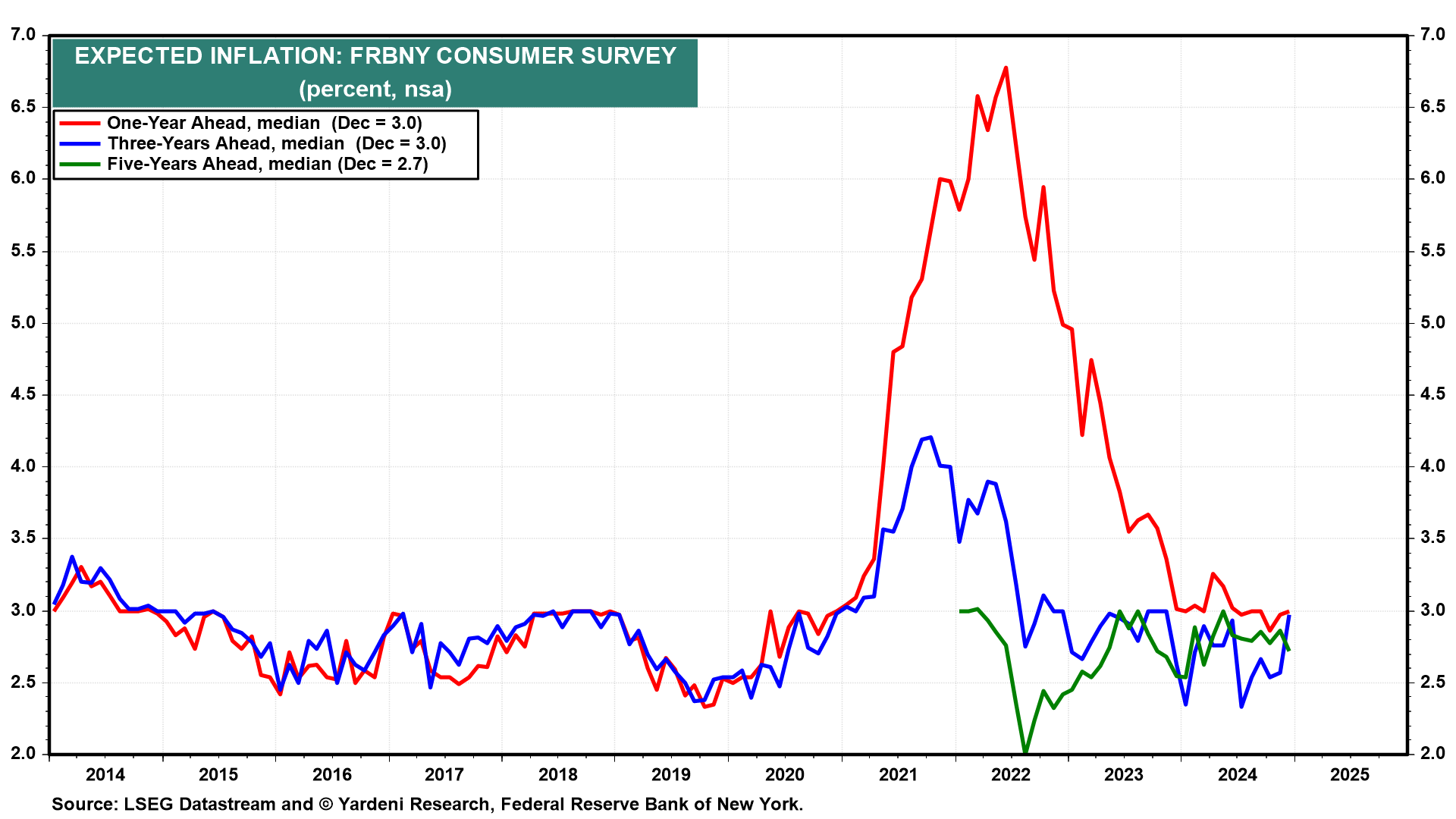
Treasury breakeven inflation remains historically normal, though a recent decoupling of its relationship with oil prices suggests that bond investors may be getting more worried about inflation.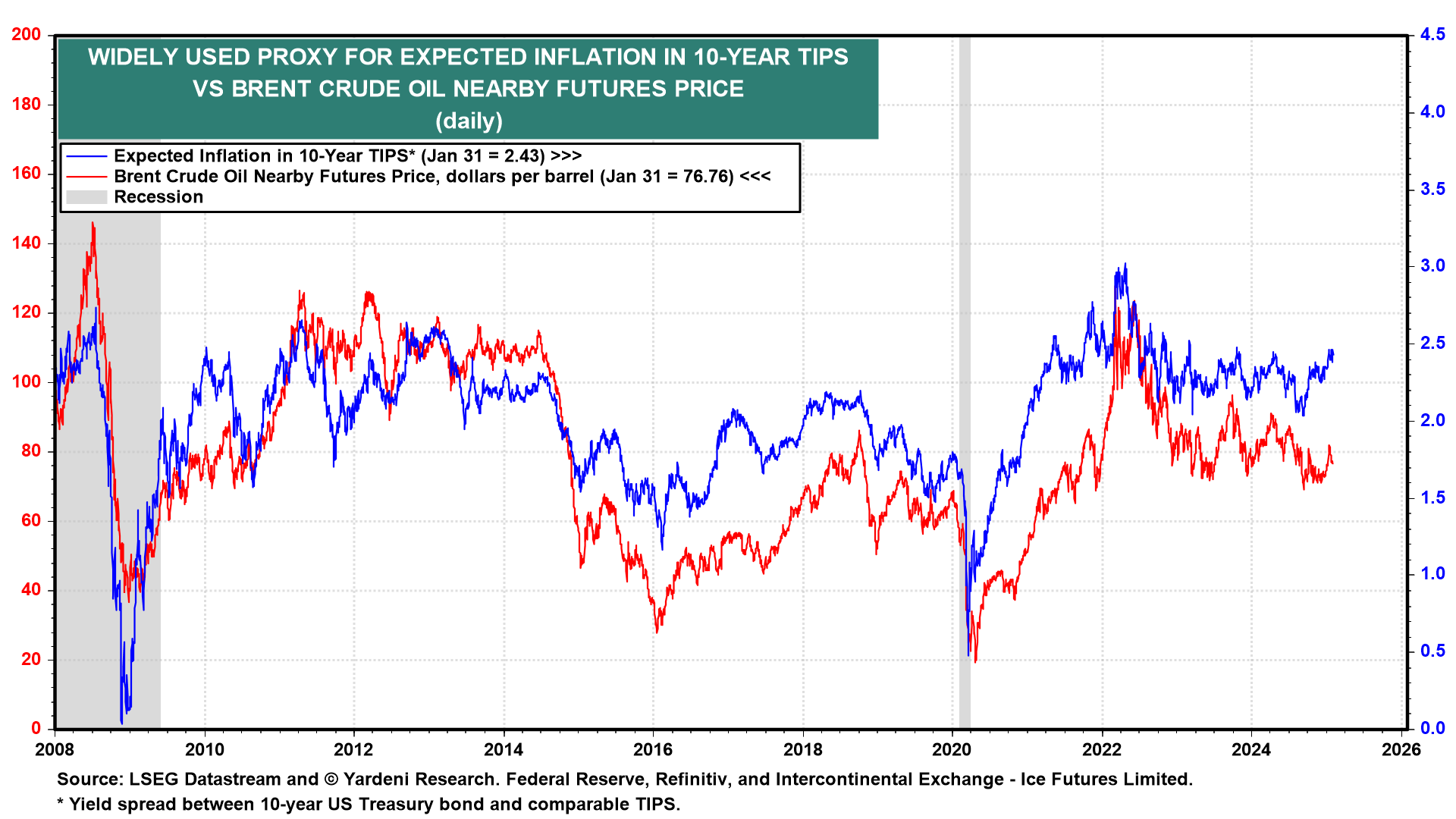
But tariffs may not feed through to inflation expectations unless there is substantial stimulus to demand.
(2) Demand. Tariffs during Trump 1.0 neither boosted overall consumer inflation nor dented demand. Personal consumption expenditures (PCE) across goods and services were normal throughout Trump 1.0. Durable goods spending fell negative in Q1-2019; however, the Fed was also reducing its balance sheet and raising rates during this time (so much so that the Fed overdid it and reversed course later that year).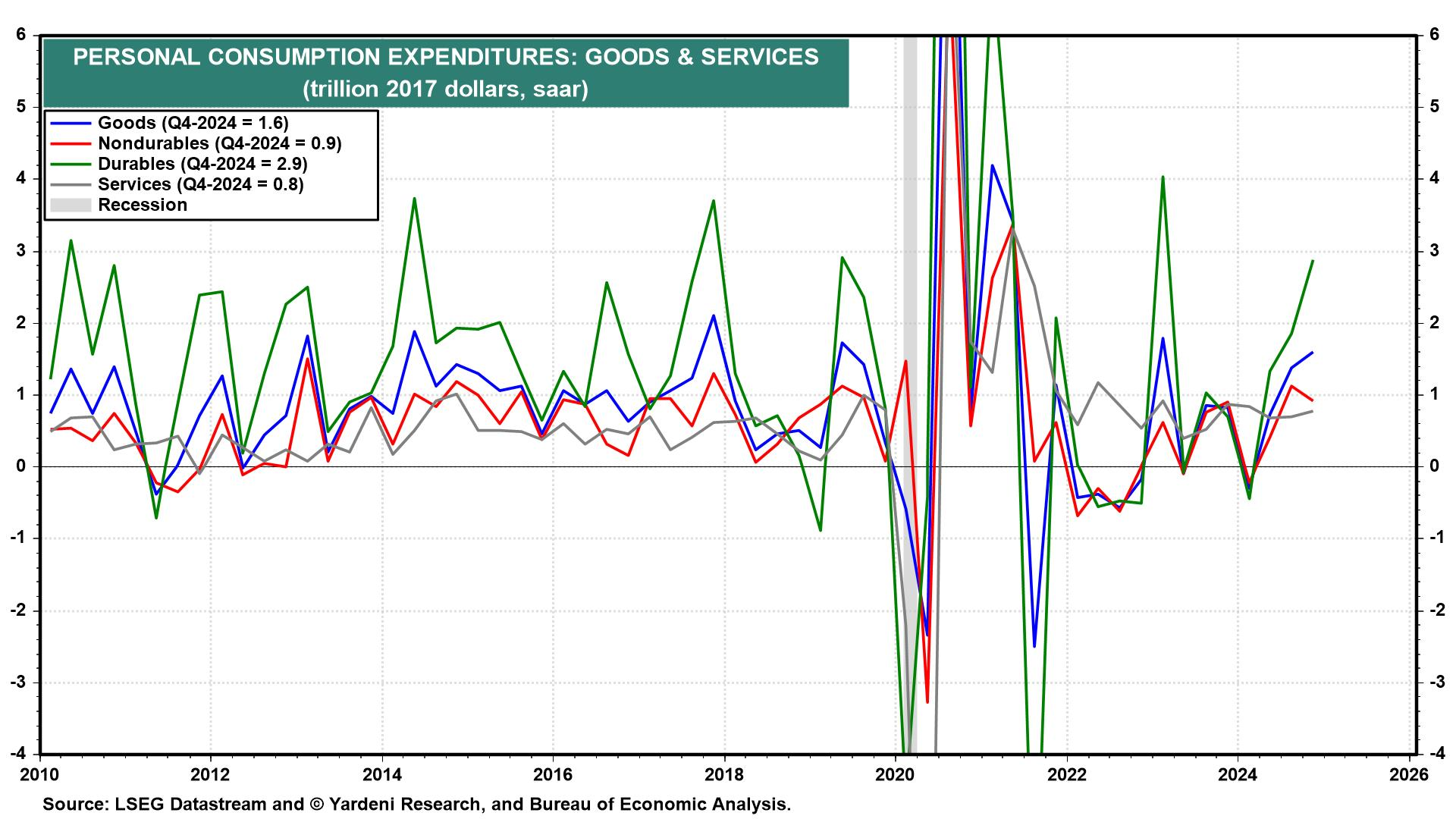
Lower tax rates are a form of stimulus, but the delta from a 21% corporate tax rate to 15% rate and the extension of the TCJA is dwarfed by Trump 1.0’s fiscal stimulus. If anything, the overall fiscal impulse is likely to decline. Given the ISM M-PMI’s latest rise into expansion above 50.0 and normalizing consumer demand for goods, we do not think demand will dramatically fall due to tariffs nor will it accelerate because of stimulus. This would be somewhat of a Goldilocks outcome amid a reordering of global trade.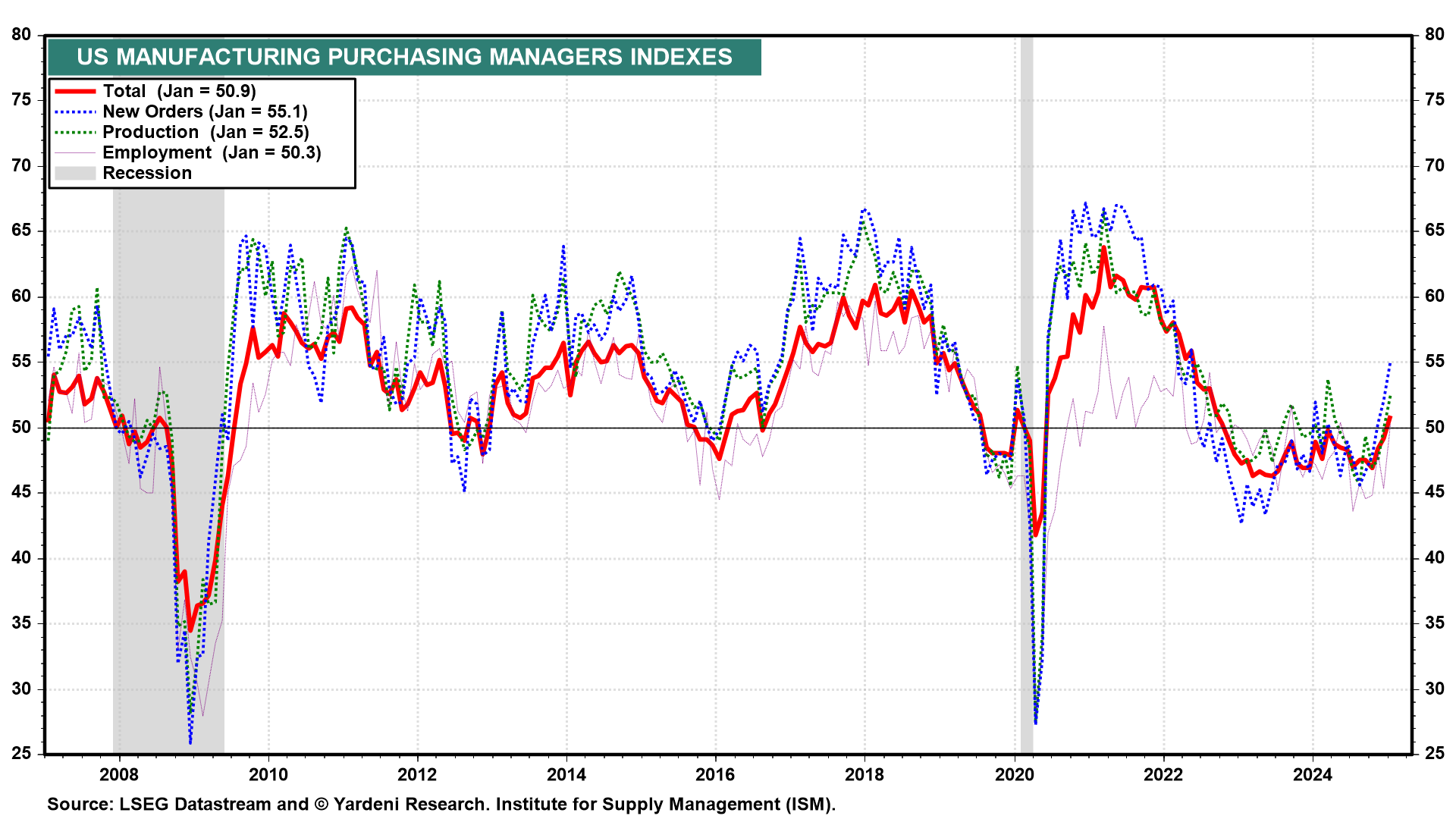
(3) Labor. We understand concerns about the cost of labor rising, as producers may have to shift from reliance on foreign workers to more expensive US labor, and many of the cheapest workers in America are either being deported or prevented/discouraged from entering the country. That said, labor costs weren’t a major issue during Trump 1.0.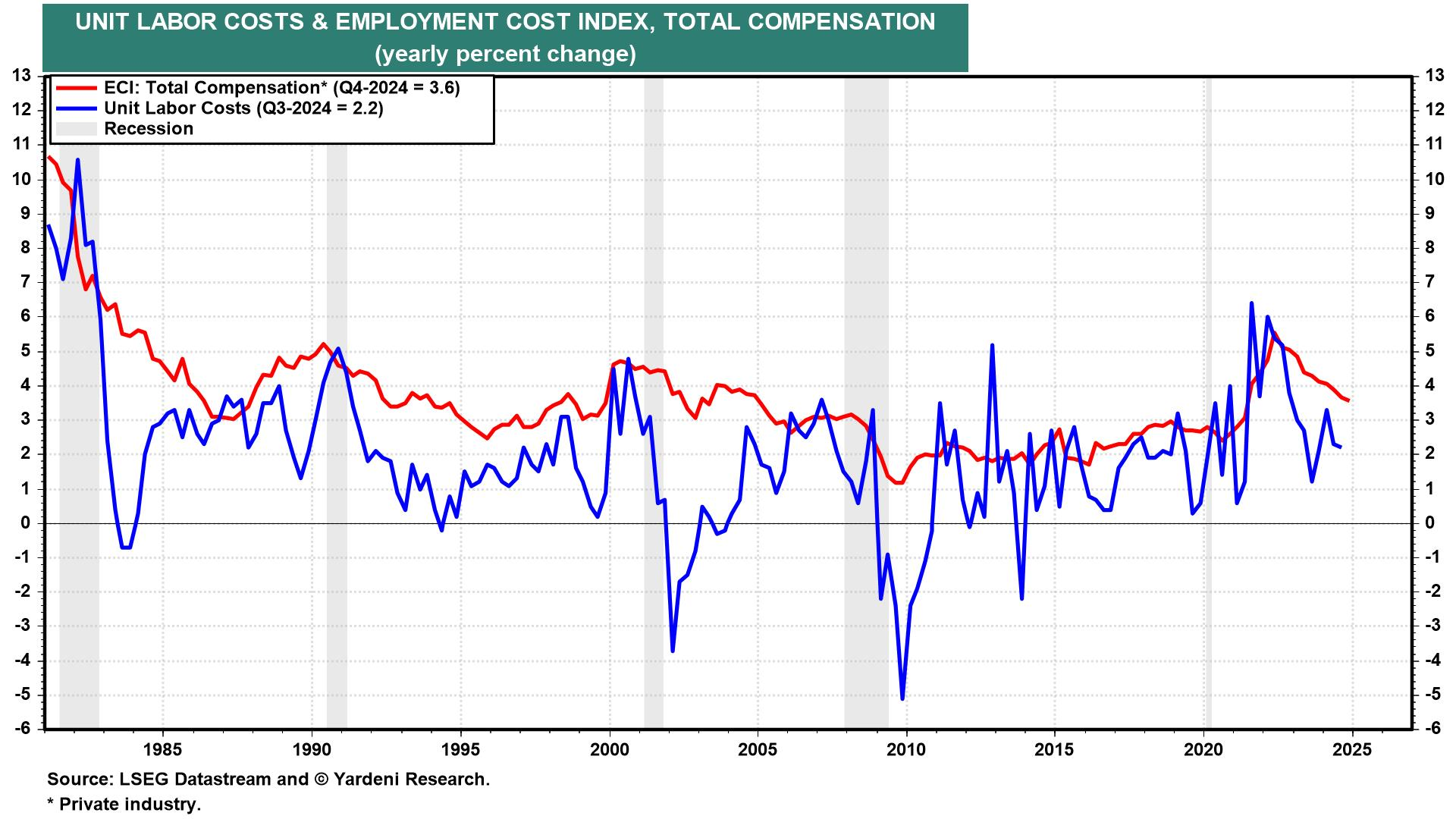
Despite record immigration over the southern border, labor costs soared during the Biden administration due to massive amounts of fiscal stimulus and monetary easing. We believe productivity growth will contain unit labor costs while boosting real wages as it rises toward 3.0% y/y.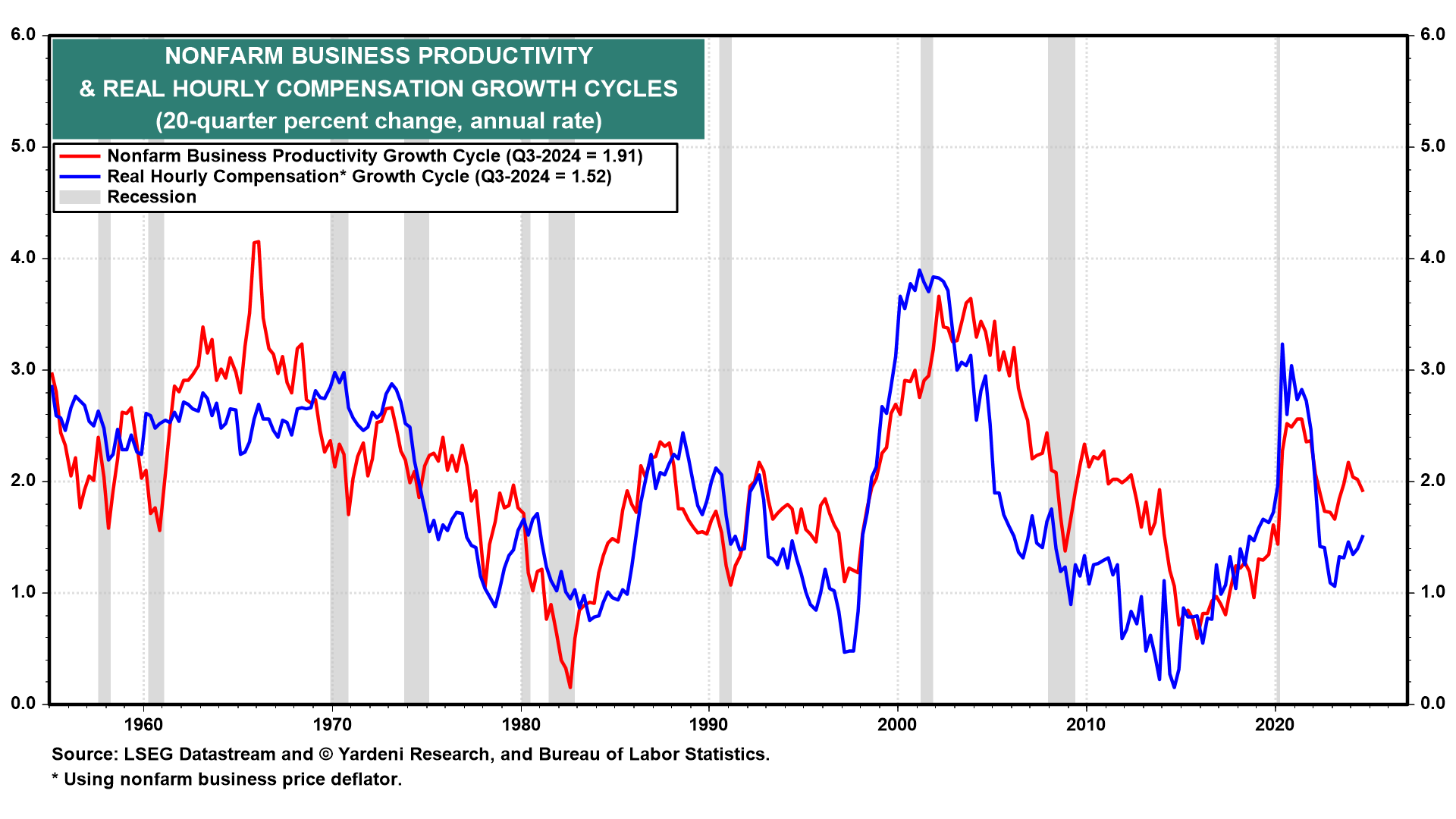
Also, more money to American workers means more spending power for American consumers.
(4) China. China’s exports are surging. China’s imports have plateaued for years. Export-oriented economies like China rely on the US to consume their goods. That’s especially true for China these days given the Chinese Communist Party’s (CCP) attempt to export its way out of the economic malaise stemming from a property-market bust. Outside of certain critical minerals, the US is far less dependent on China than China is dependent on the US and its other trading partners.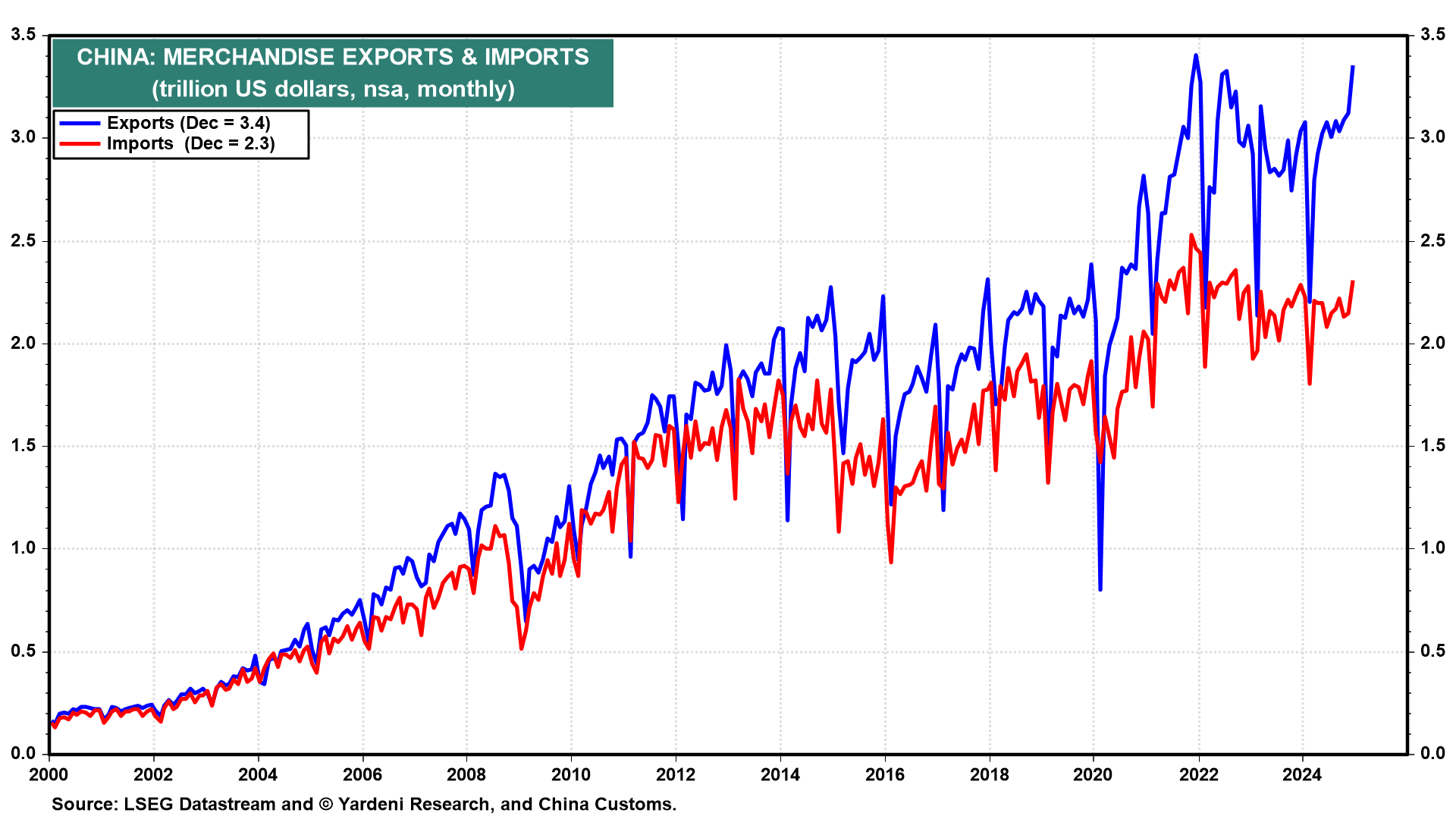
While China could devalue its currency to offset the impact of tariffs—which we expect will be substantial once they are implemented (either late Q1 or in Q2)—the yuan is already nearing levels that risk capital flight.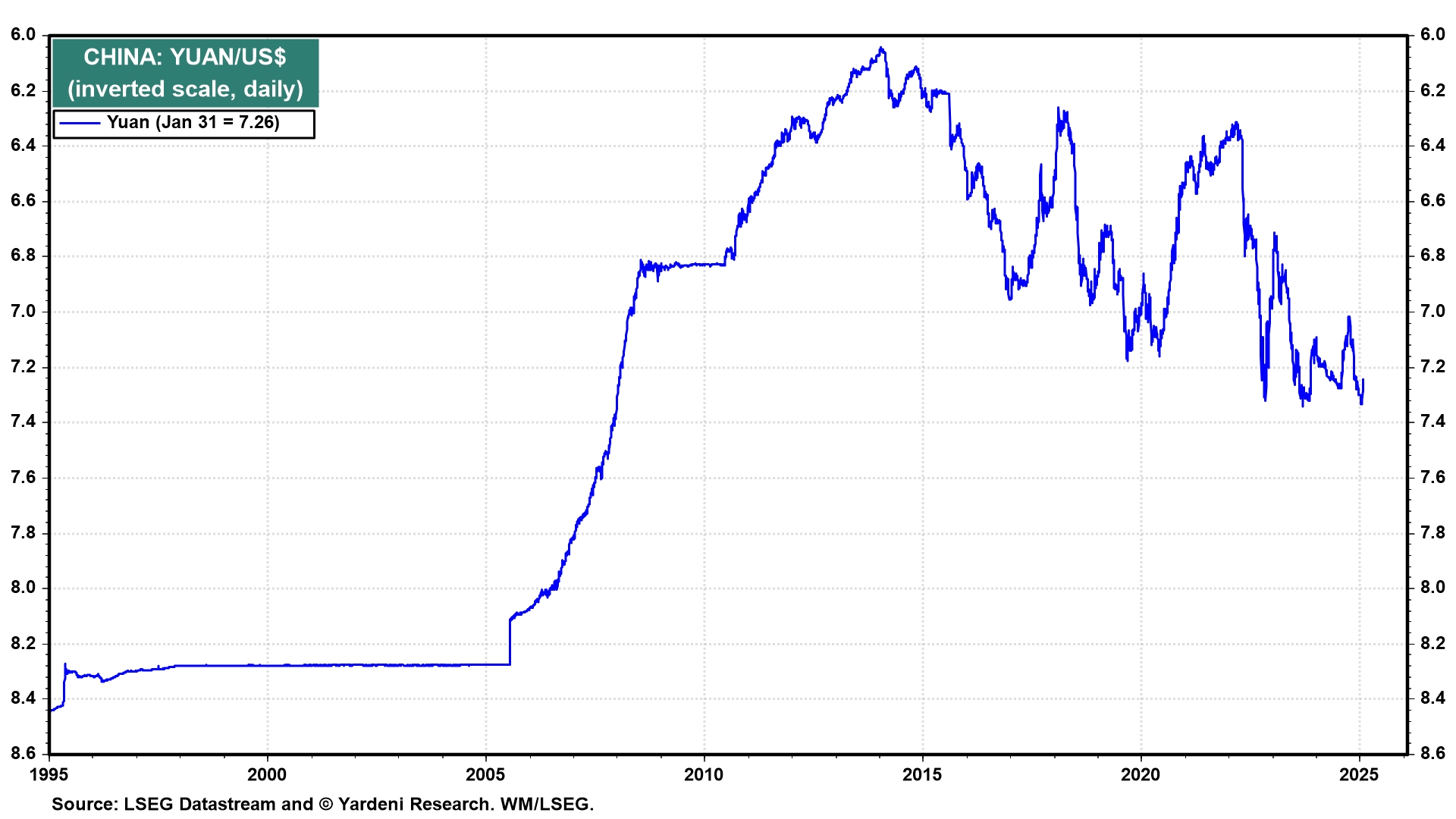
Maneuvering around tariffs via Vietnam or Mexico is unlikely to prove as successful as it was during Trump 1.0 this time around. Unless China’s autocratic state completely reorders its economy, the burden to reach a “deal” by making concessions is much more likely to fall on the CCP than the US.
